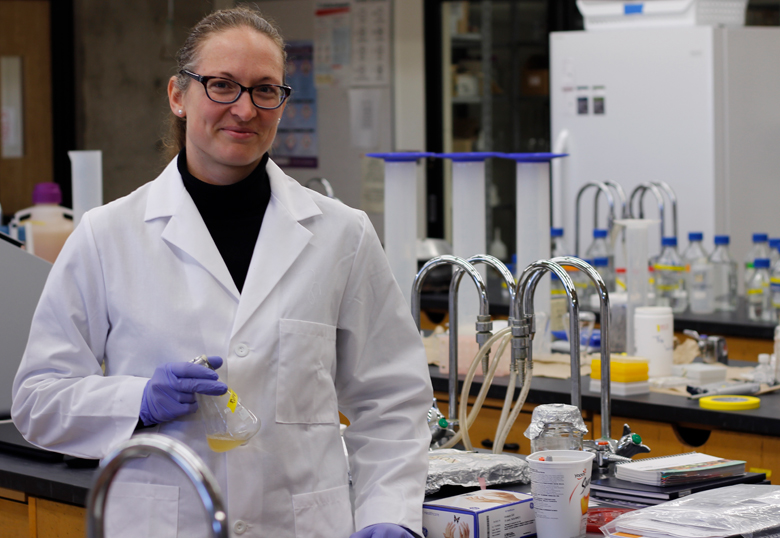A unique research partnership between the University of Lethbridge and the University of Calgary has Dr. Vanessa Meier-Stephenson using Highway 2 as a pathway to developing a greater understanding of the hepatitis C virus, and potential new therapeutics to combat the infectious disease.

Supported by a CanHepC Network Post-doctoral Fellowship, Meier-Stephenson is utilizing the laboratory expertise of the U of L’s Dr. Trushar Patel in collaboration with UCalgary’s Dr. Carla Coffin as she explores how the Hepatitis C virus hijacks one of our cell’s proteins responsible for the virus’s replication, liver disease and cancer-causing pathways.
The hepatitis C virus affects more than 71 million people worldwide and is linked to liver diseases and liver cancers.
“We actually have a lot of great drug therapies for people who are affected by hepatitis C but there are still a lot of unanswered questions about this virus in terms of how it causes liver diseases and how it leads to some of the different cancers that we see,” says Meier-Stephenson. “I will be analyzing the interaction between the virus and the cell protein using various biochemical, biophysical and cell culture techniques in order to determine the specifics of the interaction, including its 3D-structural basis.”
To attack this problem, a collaborative effort is being employed through a combined post-doctoral study, mining the expertise of two of the province’s most advanced research programs.
“There’s no single lab in Alberta that would have all the components we’re using to approach this problem, but by combining the strengths of the two labs, we can accomplish so much more with our research,” says Meier-Stephenson. “They’re completely different labs in terms of what they bring to the table but they fit together so nicely for this project.”
A Newfoundland native, Meier-Stephenson did her undergraduate work at Mount Allison University and completed her PhD at Dalhousie University in Halifax. While she pursued medicine and currently practices as an infectious diseases physician, she’s still fascinated by lab work and research into drug design and discovery. As a clinician, she says it can be difficult treating patients with gaps in knowledge and lack of effective treatments.
“There are so many viruses we have absolutely no treatment for,” says Meier-Stephenson. “At least for hepatitis B and C, and HIV, we have some treatments, but they’re more just to suppress the virus rather than get rid of it. It can be disheartening that there are instances when you can’t do anything other than support a patient. I’d like to be able to take it beyond the diagnosis and say, “Yes, we’ve now figured out a way to treat this and this is how I can help you.” Having some of those skill sets that can lead to treatment, I feel I should at least try.”
Working with viruses related to hepatitis C and similar mechanisms they use to hijack cell proteins, Meier-Stephenson says it was natural to branch off into this study when funding from the CanHepC Network became available. Her first conversation with Coffin revealed how she had collaborated with the U of L’s Patel and it opened up new opportunities.
“Dr. Patel has the capacity for the biophysical studies, digging down to the very structural nature of all these compounds. He brings that expertise where he’s able to study the interactions between various cellular components, not just for viruses, but for all sorts of systems,” says Meier-Stephenson. “Dr. Coffin brings all the clinical aspects that link these together. She has a strong basic science lab as well, but from a different perspective using sequencing methods and DNA-specific approaches to study mechanistic and immunologic phenomena in clinically-relevant samples.”
Meier-Stephenson says the cooperative approach adds greater perspective to the work and opens further windows for collaboration when the respective research networks of Patel and Coffin are also in the picture.
“To really advance research, we have to collaborate and work together, because it makes for stronger, more relevant results,” she says. “It helps move things forward, where if we tried to do it all on our own, we just wouldn’t get that same breadth of what we’re doing now.”
The fellowship is a two-year award, after which Meier-Stephenson would like to have her own lab established.
“By the end of the award term, I’m hoping to have my own independent research program, with the goal of doing something similar to what I’m doing now, a mix between the two disciplines that both Drs. Coffin and Patel are doing, ultimately working towards viral treatments.”
Meier-Stephenson is inspired by the considerable contributions other Canadian researchers have brought to the study of infectious diseases, citing Winnipeg’s National Microbiology Laboratory’s development of an Ebola vaccine, Mike Houghton’s isolation/co-discovery of the hepatitis C virus and Lorne Tyrell’s work on the mainstay treatment of hepatitis B and HIV (Lamivudine).
“Canada has really been showing itself as a major player in the virology field and there’s no reason to think we can’t be part of something similar.”

